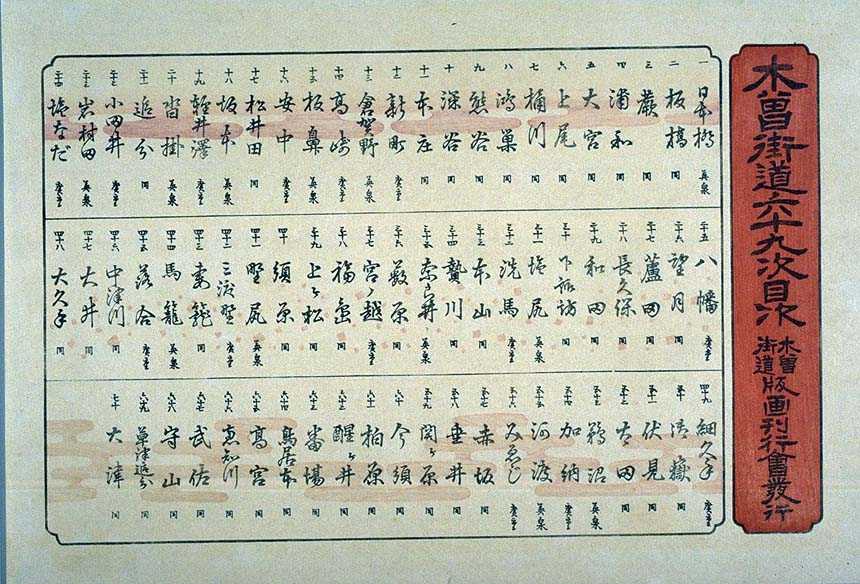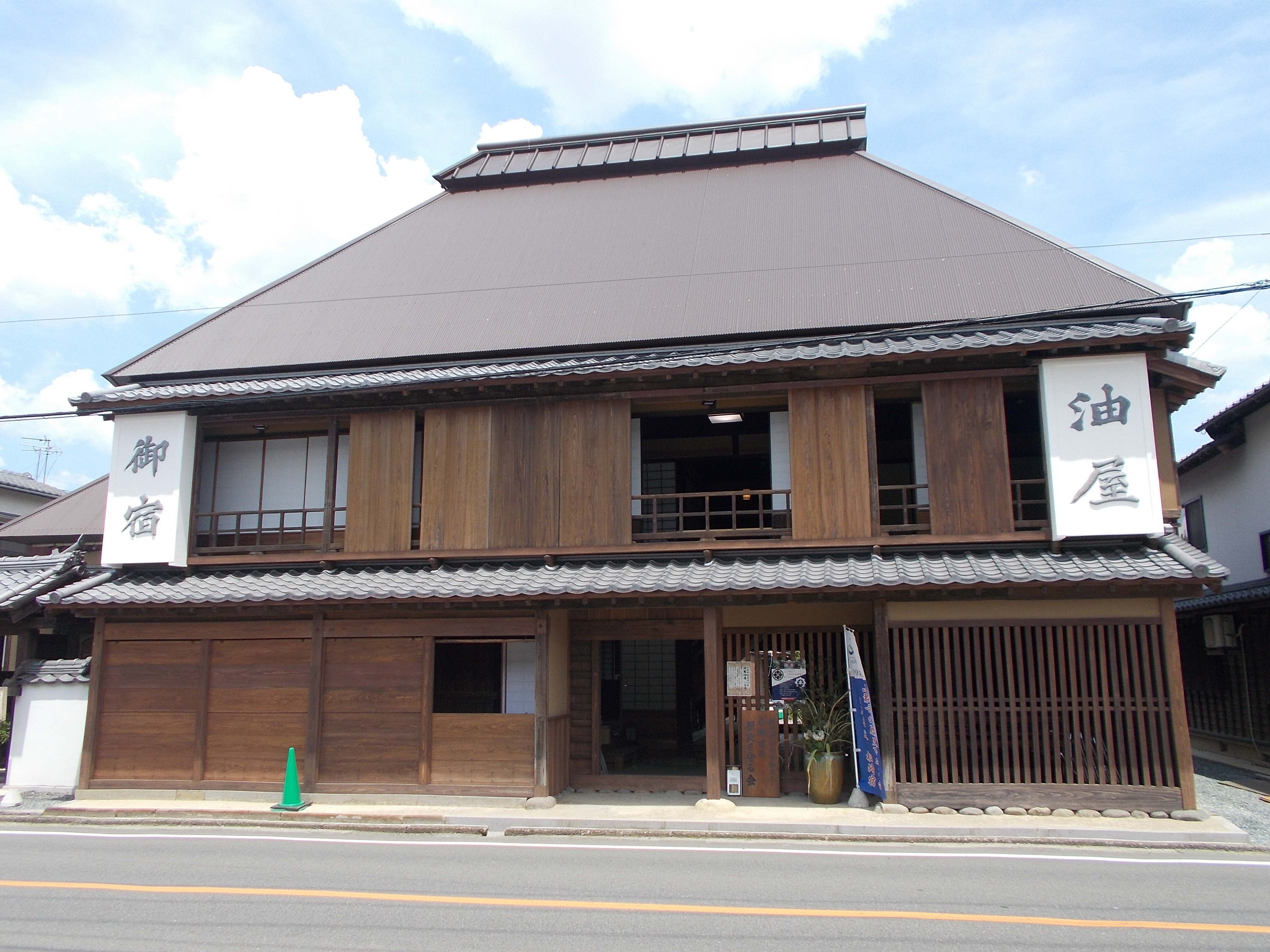|
Kashiwabara-juku
Kashiwabara-juku today was the sixtieth of the sixty-nine stations of the Nakasendō highway connecting Edo with Kyoto in Edo period Japan. It was located in the present-day city of Maibara, Shiga Prefecture, Japan. History Kashiwabara-juku was located on the ancient Tōsandō highway connecting the capital of Heian-kyō with the provinces of eastern Japan, and near the border of Ōmi Province with Mino Province. A post station was first established in the Kashiwabara-juku area in 646.Kashiwabara-juku Rekishi Maibara-shi Kashiwabara-juku Rekishikan. Accessed July 18, 2007. It is mentioned in then medieval chronicle '''' In the early |
The Sixty-nine Stations Of The Kiso Kaidō
The or ''Sixty-nine Stations of the Kiso Road'', is a series of ''ukiyo-e'' works created by Utagawa Hiroshige and Keisai Eisen. There are 71 total prints in the series (one for each of the 69 post stations and Nihonbashi; Nakatsugawa-juku has two prints). The common name for the Kiso Kaidō is "Nakasendō" so the series is sometimes referred to as the ''Sixty-nine Stations of the Nakasendō''. It is a follow up to Hiroshige's ''The Fifty-three Stations of the Tōkaidō'' and he produced 47 of the prints, with Eisen being responsible for the rest.Hiroshige - Kisokaido www.hiroshige.org.uk. Accessed November 1, 2017. The series was published by Iseya Rihei (Kinjudō) from .Forrer The Naka ...
|
Maibara, Shiga
is a city in Shiga Prefecture, Japan. , the city had an estimated population of 38,259 in 14761 households and a population density of 150 persons per km². The total area of the city is . Geography Maibara is located in northcentral Shiga Prefecture, on the eastern shore of Lake Biwa, and extending inland to the Ibuki Mountains and the border with Gifu Prefecture. Parts of the city are within the borders of the Biwako Quasi-National Park. Mount Ibuki is in the northeastern part of the prefecture. It is the highest peak in the prefecture. The Anegawa River and Amanogawa River pass through they city. About 70 percent of the city is forest. Neighboring municipalities Shiga Prefecture * Nagahama *Hikone * Taga Gifu Prefecture *Ōgaki *Ibigawa *Sekigahara Climate Maibara has a Humid subtropical climate (Köppen ''Cfa'') characterized by warm summers and cool winters with heavy snowfall. The average annual temperature in Maibara is . The average annual rainfall is with Septem ... [...More Info...] [...Related Items...] OR: [Wikipedia] [Google] [Baidu] |
69 Stations Of The Nakasendō
The are the rest areas along the Nakasendō, which ran from Nihonbashi in Edo (modern-day Tokyo) to Sanjō Ōhashi in Kyoto.Yama to Keikoku Publishing (2006). Nakasendō o Aruku (Revised ed.). Osaka: Yama to Keikoku Publishing. .Nakasendō Jōhō . NEC Corporation. Accessed August 18, 2007. The route stretched approximately and was an alternate to the Tōkaidō. 
|
Shukuba
were post stations during the Edo period in Japan, generally located on one of the Edo Five Routes or one of its sub-routes. They were also called ''shuku-eki'' (宿駅). These post stations (or "post towns") were places where travelers could rest on their journey around the nation. They were created based on policies for the transportation of goods by horseback that were developed during the Nara and Heian periods. History These post stations were first established by Tokugawa Ieyasu shortly after the end of the Battle of Sekigahara. The first post stations were developed along the Tōkaidō (followed by stations on the Nakasendō and other routes). In 1601, the first of the Tōkaidō's fifty-three stations were developed, stretching from Shinagawa-juku in Edo to Ōtsu-juku in Ōmi Province. Not all the post stations were built at the same time, however, as the last one was built in 1624. The lodgings in the post stations were established for use by public officials and, ... [...More Info...] [...Related Items...] OR: [Wikipedia] [Google] [Baidu] |
Mount Ibuki
is a mountain, on the border of Maibara, Shiga Prefecture, and Ibigawa, Gifu Prefecture, Japan. It is one of the 100 Famous Japanese Mountains, and is also included on the lists of the 100 Kinki Mountains and the 50 Shiga Mountains. Mount Ibuki is the highest mountain in Shiga Prefecture. Outline Mount Ibuki is the highest peak in the Ibuki Mountains, which stretch from north to south along the border of Shiga Prefecture and Gifu Prefecture. Located at the southern end of the mountain chain with the Suzuka Mountains not too far to the south, a small plain at the foot of this mountain, Sekigahara, became one of the most important strategic points throughout Japanese history. Nature Since ancient times, Mount Ibuki has also been known for its rich variety of wild plants and animals, as well as for its beautiful shape. Climate Mount Ibuki has a humid continental climate (Köppen climate classification ''Dfb'') with mild summers and cold winters. On February 14 1927, 230 centime ... [...More Info...] [...Related Items...] OR: [Wikipedia] [Google] [Baidu] |
Moxibustion
Moxibustion () is a traditional Chinese medicine therapy which consists of burning dried mugwort ('' wikt:moxa'') on particular points on the body. It plays an important role in the traditional medical systems of China, Japan, Korea, Vietnam, and Mongolia. Suppliers usually age the mugwort and grind it up to a fluff; practitioners burn the fluff or process it further into a cigar-shaped stick. They can use it indirectly, with acupuncture needles, or burn it on the patient's skin. Moxibustion is promoted as a treatment for a wide variety of conditions, but its use is not backed by good evidence and it carries a risk of adverse effects. Terminology The first Western remarks on moxibustion can be found in letters and reports written by Portuguese missionaries in 16th-century Japan. They called it ''botão de fogo'' ("fire button"), a term originally used for round-headed Western cautery irons. Hermann Buschoff, who published the first Western book on this matter in 1674 (Engli ... [...More Info...] [...Related Items...] OR: [Wikipedia] [Google] [Baidu] |
Honjin
The ''honjin'' at Inaba Kaidō's Ōhara-shuku.">Ōhara-shuku.html" ;"title="Inaba Kaidō's Ōhara-shuku">Inaba Kaidō's Ōhara-shuku. is the Japanese word for an inn for government officials, generally located in post stations (''shukuba'') during the later part of the Edo period. Evolution of ''Honjin'' Originally, ''honjin'' were places from which generals directed battles and, therefore, were fleeting in nature. However, as commanders began to transform the ''honjin'' into temporary lodgings during battle and travel, ''honjin'' came to be places where ''daimyō'' and other representatives of the shogunate, including ''hatamoto'', ''monzeki'', etc., were allowed to stay during their travels. Many of the ''honjin'' were actually personal residences of village and town leaders. As such, they received official designations from the government and expanded their residences to include walls, gates and other features. Because of their cooperation, the owners of the ''honjin'' also ... [...More Info...] [...Related Items...] OR: [Wikipedia] [Google] [Baidu] |
Hatago
were Edo period lodgings for travelers at '' shukuba'' (post stations) along the national highways, including the Edo Five Routes The , sometimes translated as "Five Highways", were the five centrally administered routes, or ''kaidō'', that connected the ''de facto'' capital of Japan at Edo (now Tokyo) with the outer provinces during the Edo period (1603–1868). The most ... and the subroutes. In addition to a place to rest, ''hatago'' also offered meals and other foods to the travelers. They were also called . Name origin ''Hatago'' means "traveling basket." The word itself originally derived from baskets that contained food for horses and were carried by travelers. From there, it became a tool with which travelers were carry their own food and goods. Shops that began preparing and selling food for travelers gained the suffix , meaning "shop," but this was eventually shortened to just ''hatago''. Preserved ''hatago'' Because many post stations along the Tōkaidō, Nakas ... [...More Info...] [...Related Items...] OR: [Wikipedia] [Google] [Baidu] |
Meiji Period
The is an era of Japanese history that extended from October 23, 1868 to July 30, 1912. The Meiji era was the first half of the Empire of Japan, when the Japanese people moved from being an isolated feudal society at risk of colonization by Western powers to the new paradigm of a modern, industrialized nation state and emergent great power, influenced by Western scientific, technological, philosophical, political, legal, and aesthetic ideas. As a result of such wholesale adoption of radically different ideas, the changes to Japan were profound, and affected its social structure, internal politics, economy, military, and foreign relations. The period corresponded to the reign of Emperor Meiji. It was preceded by the Keiō era and was succeeded by the Taishō era, upon the accession of Emperor Taishō. The rapid modernization during the Meiji era was not without its opponents, as the rapid changes to society caused many disaffected traditionalists from the former samurai ... [...More Info...] [...Related Items...] OR: [Wikipedia] [Google] [Baidu] |
Kyōgoku Clan
The were a Japanese ''daimyō'' clan which rose to prominence during the Sengoku period, Sengoku and Edo period, Edo periods. The clan descend from the Emperor Uda, Uda Minamoto clan, Genji through the Sasaki clan.Papinot, Jacques. (2003)''Nobiliare du Japon'', pp. 27–28./ref> The name derives from the Kyōgoku quarter of Kyoto during the Heian period.Iwao, Seiichi ''et al.'' (2002) ''Dictionnaire historique du Japon'', p. 1704./ref> The Kyōgoku acted as ''shugo'' (governors) of Ōmi Province, Ōmi, Hida Province, Hida, Izumo Province, Izumo and Oki Provinces in the period before the Ōnin War. A period of decline in clan fortunes was mitigated with the rise of the Tokugawa clan. Members of the clan were ''daimyōs'' of territories on the islands of Kyūshū and Shikoku during the Edo period. Under the Tokugawa shogunate, the Kyōgoku were identified as ''Tozama daimyō, tozama'' or outsiders, in contrast with the ''Fudai daimyō, fudai'' or insider ''daimyō'' clans which ... [...More Info...] [...Related Items...] OR: [Wikipedia] [Google] [Baidu] |
Tokugen-in
is a Buddhist temple in the Kiyotaki neighborhood of the city of Maibara, Shiga Prefecture Japan. It belongs to the Tendai school of Japanese Buddhism and its main image is a ''hibutsu'' statue of Sho-Kannon Bosatsu. The temple is noted as the ''bodaiji'' of the Kyōgoku clan, a prominent Sengoku and Edo period ''daimyō'' clan. The clan cemetery was designated a National Historic Site in 1936. History Tokugen-in is also known as . It was established in 1283 by the founder of the Kyōgoku clan, Kyōgoku Ujinobu, who was ''shugo'' of Ōmi Province. The Kyōgoku clan descended from the Uda Genji through the Sasaki clan.Papinot, Jacques. (2003)''Nobiliare du Japon'', pp. 27–28./ref> Their name derives from the Kyōgoku quarter of Kyoto during the Heian period.Iwao, Seiichi ''et al.'' (2002) ''Dictionnaire historique du Japon'', p. 1704./ref> The Kyōgoku served as ''shugo'' of Ōmi, Hida, Izumo and Oki Provinces at various times in the period before the Ōnin War. In 167 ... [...More Info...] [...Related Items...] OR: [Wikipedia] [Google] [Baidu] |
Bodaiji
A in Japanese Buddhism is a temple which, generation after generation, takes care of a family's dead, giving them burial and performing ceremonies in their soul's favor.Iwanami kojien The name is derived from the term , which originally meant just Buddhist enlightenment (satori), but which in Japan has also come to mean either the care of one's dead to ensure their welfare after death or happiness in the beyond itself. Several samurai families including the Tokugawa had their ''bodaiji'' built to order, while others followed the example of commoners and simply adopted an existing temple as family temple. Families may have more than one ''bodaiji''. The Tokugawa clan, for example, had two, while the Ashikaga clan had several, both in the Kantō and the Kansai areas. Some famous ''bodaiji'' *The Hōjō clan's Tōshō-ji in Kamakura (Kamakura period) (destroyed in 1333) *The Hōjō clan's Hōkai-ji in Kamakura (Muromachi period) *The Ashikaga's Tōji-in in Kyoto (Muromachi perio ... [...More Info...] [...Related Items...] OR: [Wikipedia] [Google] [Baidu] |





